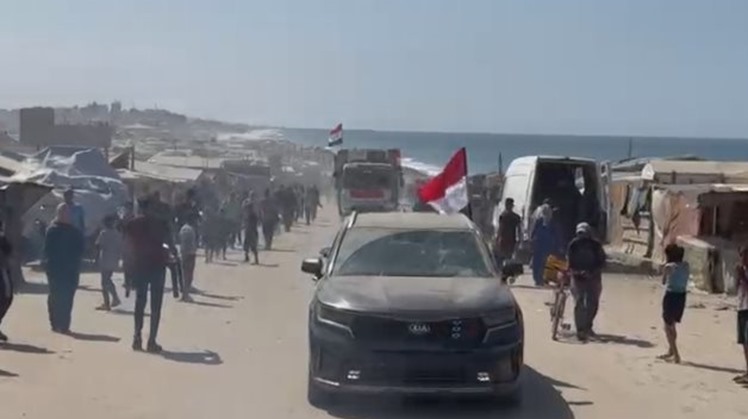CAIRO – 10 October 2025: Egyptian flags waved at the forefront as displaced families began their return to the north of Gaza on Friday, amid a steady stream of Egyptian aid convoys crossing into the area to deliver urgent relief supplies.
The ceasefire in Gaza, brokered under Egypt’s mediation, marks a critical turning point after 735 days of relentless war that left deep scars across the enclave.
Tel Aviv and Hamas agreed on a ceasefire agreement and a prisoner swap deal after intensive talks in Egypt’s Sharm El-Sheikh city this week.
The talks involved US envoys Steve Witkoff and Jared Kushner, intelligence chiefs of Egypt and Turkey, and Qatar’s prime minister. The agreement forms the first phase of a peace plan outlined by US President Donald Trump.
The Sharm El-Sheikh agreement has brought a calm after two years of devastation that claimed tens of thousands of lives.
The Israeli army announced that a ceasefire agreement officially came into effect as of 12:00 Friday.
The Israeli army announced in a post on X that they have repositioned along updated deployment lines in line with the ceasefire terms and the arrangements for the return of captives.
However, the army warned that forces under the Southern Command remain active in the area, maintaining readiness to “eliminate any immediate threat.”
As the guns fell silent on Friday, ululations of joy echoed through Gaza City.
Crowds of men, women, and children poured into the streets, waving Egyptian flags in gratitude to Cairo’s tireless efforts to end the bloodshed. For many, the sight of peace, however tentative, offered the first glimpse of hope in years.
As ceasefire took hold, thousands of displaced residents began moving northward through Al-Rashid and Salah Al-Din streets, returning to neighborhoods reduced to rubble yet still called home.
In parallel, Egyptian humanitarian aid convoys rolled steadily across the Rafah border.
From the Egyptian side of the crossing, trucks from the 48th “Zad Al-Ezza – From Egypt to Gaza” convoy made their way to the Karam Abu Salem crossing in southern Gaza.
A source at the Rafah terminal noted that the convoy carried food supplies, medical aid, shelter materials, and medicines.
In total, Egypt has sent over 580,000 tons of humanitarian and relief aid to Gaza over the past two years.
For months this year, Gaza’s crossings had remained sealed.
The Israeli army had shut all entry points on March 2, following the end of the first ceasefire phase, halting humanitarian access and barring the entry of fuel and heavy machinery essential for rebuilding destroyed neighborhoods.
Airstrikes resumed on March 18, shattering earlier hopes of a lasting truce.
Even when limited aid was allowed in May, deliveries fell far short of the enclave’s desperate needs.
The Israeli restrictions, implemented in coordination with a US security firm, drew sharp criticism from the United Nations and international relief agencies, including UNRWA, which condemned the mechanism as inconsistent with established humanitarian protocols.
Now, as trucks roll once more across the Rafah and Karam Abu Salem crossings, and as displaced families make their way home, Gaza stands at a crucial crossroads with world eyes focused on the coming days.
Under Sharm El-Sheikh agreement, Israeli forces have begun withdrawing to a designated line in Gaza within 24 hours, paving the way for Hamas to release dozens of Israeli captives, both living and deceased, within the following 72 hours.
 Fri, Oct. 10, 2025
Fri, Oct. 10, 2025